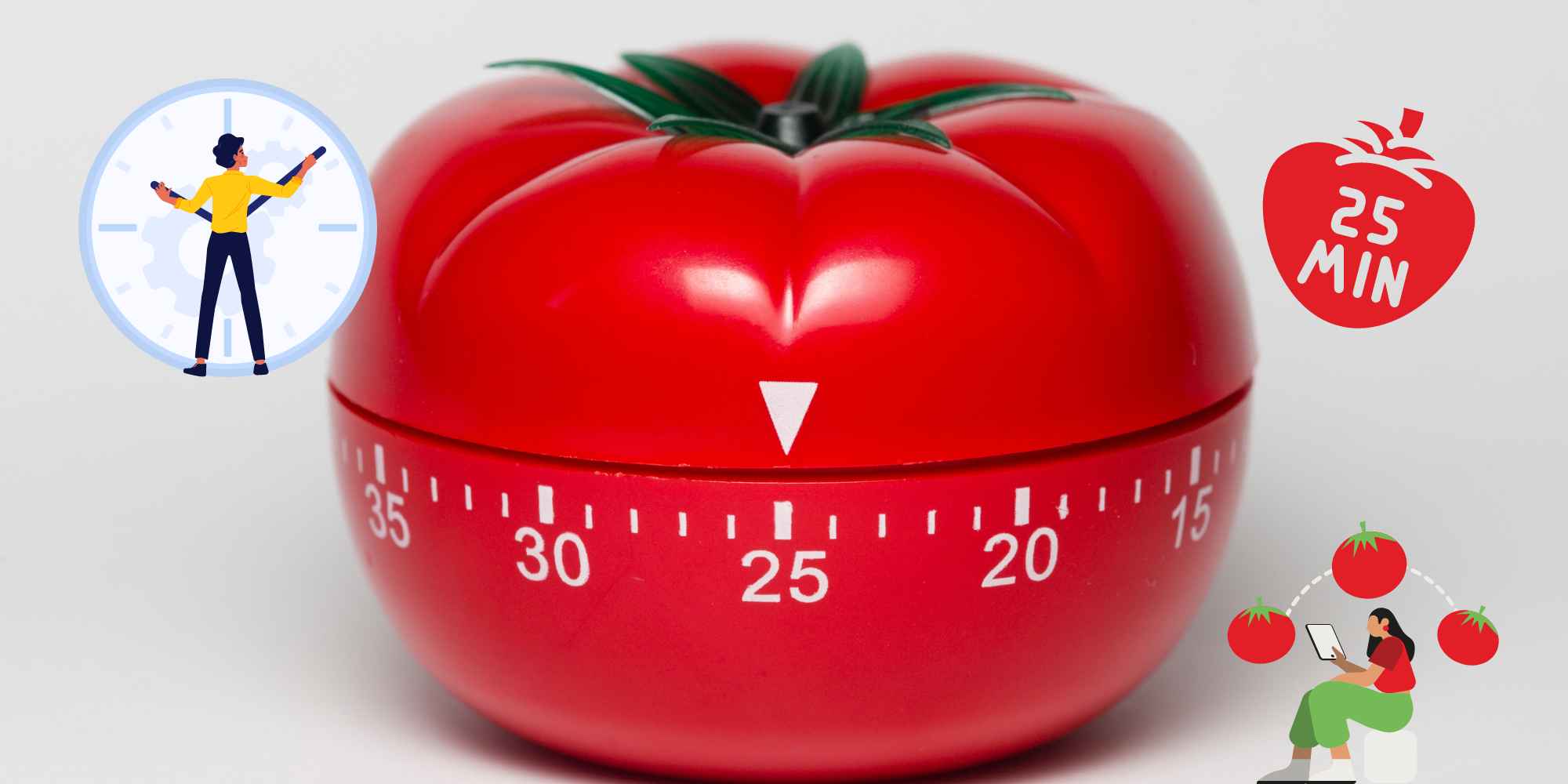How To Work With The Pomodoro Technique For Productivity
Boost your productivity with the Pomodoro technique! Dive into this comprehensive guide to understand how this time management method works. Consider its benefits, drawbacks, and how to use it effectively.

Are you tired of feeling overwhelmed by your to-do list? Do you often procrastinate and struggle to focus on tasks for extended periods of time? Enter the Pomodoro technique - a time management tool designed to boost productivity and reduce mental fatigue. In this article, we'll explain all you need to know.
I'll show you how to work with the Pomodoro technique effectively. You'll learn about the benefits it can bring to your workday. It's as simple as breaking your workday into 25-minute intervals, separated by short breaks.
The fundamental premise is to create a sense of urgency and avoid procrastination. Focusing on one task at a time allows you to make progress without feeling overwhelmed. Millions of people worldwide use this trick. You can too.
What is the Pomodoro technique?

The Pomodoro technique is a time management method conceived by Francesco Cirillo in the late 1980s [1]. It involves breaking your work sessions into timed intervals. It uses a timer to break down work into intervals. They're traditionally 25 minutes, separated by short breaks. We call these intervals pomodoros. It's plural in English for the Italian word pomodoro (tomato). Once you start, work on a single task until the timer goes off.
The underlying principle of the technique is straightforward.
- Select a task.
- Set the timer for 25 minutes.
- Work on the task until the timer goes off.
- Take a break for 5 minutes.
After completing four pomodoros, you take a longer break. You'll repeat this as many times as necessary until you complete the task.
Pomodoros don't only keep track of time. They're also about working with time. They break larger tasks into manageable chunks. That reduces the impact of interruptions on your focus and flow.
It's based on the idea that frequent breaks can improve mental agility. There's more to the technique than that, of course, but that's the gist of it. It's a simple, yet effective way to manage your time and work.
The method also gives you time to rest and recharge between work sessions. By using the Pomodoro technique, you can boost your productivity and get more done in less time.
Why the Pomodoro technique works well
The Pomodoro technique has been lauded for its effectiveness. It's effective for several reasons.

Stops procrastination
One of the biggest challenges in any work environment is procrastination. The Pomodoro technique tackles procrastination head-on. It breaks down the work into manageable chunks.
It encourages you to commit to just 25 minutes of focused work. This makes the task seem less intimidating and easier to start. This psychological trick can help you overcome the initial resistance to starting a task.
25 minutes is easy
A 25-minute interval is a manageable duration for most people [2]. This sweet spot is long enough to get substantial work done. Yet, it's short enough to prevent mental fatigue and boredom. This balance helps maintain your concentration and improve productivity.
Creates urgency
A simple ticking kitchen timer can create a sense of urgency. This can motivate you to operate more efficiently [3]. Knowing you only have a set amount of time has several effects. It keeps you on track by resisting distractions and increasing your pace.
This sense of urgency can also stimulate a state of flow. You'd become fully immersed in the task at hand. Ultimately, this leads to higher productivity.
5 reasons to use the Pomodoro technique
We've explored what the Pomodoro technique is and why it works so well. Let's now delve into five compelling reasons why you should incorporate it into your daily routine.

1. Makes work less daunting and more fun
The method breaks down tasks into manageable chunks. This makes large and complex tasks seem less intimidating. You'll no longer be staring at a giant project. You'll simply focus on a 25-minute work session. This makes tasks feel more like a game. You're trying to beat the clock, adding an element of fun to your tasks.
2. Prevents mental fatigue
Working for long, uninterrupted periods can lead to mental fatigue. This reduces your productivity over time. With regular breaks, the pomodoro method helps prevent this fatigue [2]. Regular five-minute breaks give your mind a chance to rest and recharge. You can keep your mental energy levels high throughout the day.
3. Improves quality of work
ou produce better work when you're focused and refreshed. The Pomodoro method encourages deep focus during each work session. Regular breaks help maintain your freshness [3]. You'll notice a sizable improvement in the quality of your work.
4. Lets you concentrate
Distractions are everywhere in the digital age. You'll be combating this by dedicating your full attention to one task at a time. Knowing that you have a break coming up can make it easier to resist the pull of distractions. This allows you to concentrate fully on your task.
5. Increases your motivation
The Pomodoro method can also boost your motivation. Each 25-minute pomodoro gives you a sense of accomplishment. This can spur you on to complete more.
Incorporating this tool into your daily routine can be beneficial. You'll see a sharp improvement in your overall time management and productivity.
How to use the Pomodoro technique effectively
We've just discussed the benefits of the Pomodoro Technique. Let's now look at how to use it effectively.

Get a timer or app
Grab a timer or download an app. This helps you plan ahead. It's important to have a device to keep track of your intervals. Otherwise, you'd get distracted by the time. With a timer or app, you can easily set the intervals and focus on what you're doing.
You could try this online pomodoro timer.
Plan ahead
Planning ahead for your tasks is also crucial. You need to know what you want to accomplish during each interval. This helps you stay on track and avoid wasting time. Remember, failing to plan is planning to fail!
Before you start your first pomodoro, take a few minutes to plan out what you want to do. Having a clear plan can help you avoid wasting time. Less time deciding means more time to be productive.
Drawbacks of the Pomodoro technique
It's important to note that the Pomodoro method isn't may not work for everyone. Like any productivity method, it has its drawbacks. It may not be the best fit for you. Let's explore some of its downsides.
Inflexible time intervals
The original pomodoro uses fixed time intervals - 25 minutes of work, followed by a 5-minute break. This structure can be helpful for maintaining focus and preventing fatigue. Yet, it may not suit all tasks or all individuals. You may require longer periods of uninterrupted work. You may prefer to take breaks at different intervals.
Stress with longer tasks
This tool can make tasks seem less daunting by breaking them down. It can also create stress for longer, more complex tasks. The pressure to complete a task within a fixed time can be counterproductive. Especially if the task requires more time and thought.
Doesn't consider interruptions
The method implies that you will work undisturbed for 25 minutes at a time. This may not be realistic in all the time. A busy office environment or having children at home can create distractions. They disrupt your flow. It can be difficult to stick to its schedule.
Despite these drawbacks, many people find the Pomodoro technique useful. Try it out to see if it works for you. Remember, you can always adapt the technique to better suit your needs and your work style. If 25 minutes is too little or too much, you can adjust that.
There are also alternative effective time management tools. The Flowtime technique is an alternative with more flexibility. You can specify how long to work and how long you take breaks. Try that if you find the fixed pomodoros too restrictive.
Conclusion
In our fast-paced world, we crave effective time management. The Pomodoro technique is simple yet powerful. It's an easy, practical solution that you can incorporate into your daily routine. It's as easy as breaking tasks into manageable intervals and incorporating regular breaks. This method can help you combat procrastination and maintain focus. Use it to improve the quality of your work.
Frequently Asked Questions
Who invented the Pomodoro technique?
Francesco Cirillo invented the Pomodoro technique in the late 1980s. He developed this method during his university years to improve his own study habits [1].
Why is a pomodoro 25 minutes?
Cirillo chose the 25-minute work interval because it's a manageable amount of time that allows for focused work without leading to fatigue [1]. It's long enough to make progress on a task, but not so long that it's overwhelming or tiring.
How many pomodoros should you do in a day?
This depends on your workload and your personal capacity for focused work. It's important to maintain a balance and avoid burnout. Remember to take a longer break after every four pomodoros to rest and recharge.
Who is the Pomodoro technique best fit for?
The Pomodoro technique can help almost anyone. Anyone looking to improve their productivity and time management skills could use this. It's particularly useful for students, writers, or developers. Anyone who needs to manage multiple tasks can benefit from using it. Remember, everyone is different. What works best for one person may not work as well for another.
Can the Pomodoro technique be used for creative tasks or just for more structured work?
Absolutely, you can use pomodoros for both creative and structured tasks. The key is to focus on one task during each Pomodoro. For creative tasks, this could mean dedicating a Pomodoro to brainstorming, drafting, or revising.
Is it necessary to take breaks during the 25-minute work intervals or can you work straight through?
It's recommended to take a short break after each 25-minute work interval. Breaks prevent fatigue. They allow you to maintain focus and productivity. However, if you find yourself in a state of flow, you may choose to work through the break.
How do you deal with interruptions or unexpected tasks that come up during a Pomodoro session?
Interruptions or unexpected tasks can come up. You can deal with it quickly, if it takes less than a few minutes. You could also make a note of it and deal with it later. Get back to it during your break or after the session.
Can the Pomodoro technique be used by teams, or is it more effective for individual work?
The Pomodoro technique was originally designed for individual work. But it can be adapted for teams. For example, a team could work together for a set number of pomodoros for a specific project. They can have breaks in between.
Is there a recommended time of day to use the Pomodoro technique, or can it be used at any time?
You can be use pomodoros at any time of day. The best time to use it depends on your personal productivity rhythms. Some people find it most effective in the morning. Others prefer to use it in the afternoon or evening.
Let's learn together
Thank you for reading. Sign up for our newsletter to receive to the latest blog posts, updates, and more delivered straight to your inbox. Don't miss out on valuable insights, useful tips, and fascinating discussions. Join the growing Brief Blink community today and elevate your understanding to new heights.

